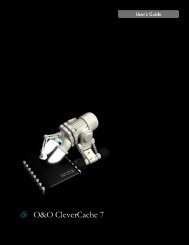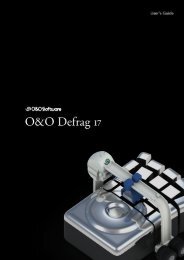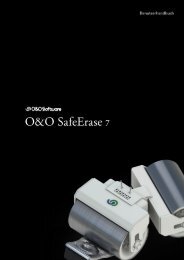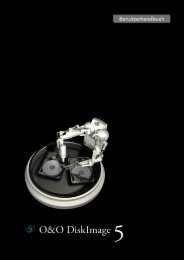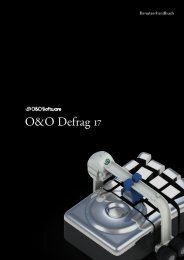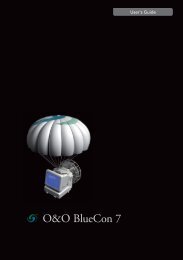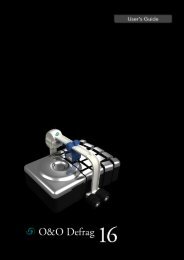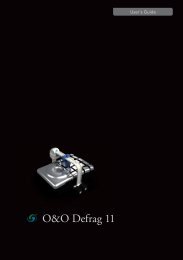O&O DiskImage 7 User's Guide - O&O Software
O&O DiskImage 7 User's Guide - O&O Software
O&O DiskImage 7 User's Guide - O&O Software
Create successful ePaper yourself
Turn your PDF publications into a flip-book with our unique Google optimized e-Paper software.
Features at a glance<br />
Adapt size of the target drive for restoration and cloning<br />
If the target for restoration or cloning is an empty area, the user can adapt the size of the target drive to the actual data<br />
volume of the source drive. When, for example, the drive being imaged has 5 GB but the data on it is only taking up half<br />
its space, a smaller drive of maybe 3 GB can be entered as a target during restoration.<br />
Cloning<br />
Cloning allows you to make 1:1 copies of entire disks or individual drives that can be used instead of the originals. This<br />
function provides you with clones of disks or individual drives, including information about the hard disk layout with all<br />
the data saved on it. Clones do, however, require a lot more storage space than an image.<br />
Unlike images, there are no incremental or differential clones possible for reducing the data volume of successive<br />
clones. In addition, a clone cannot be compressed or encrypted like an image.<br />
Cloning entire disks<br />
You can create a clone from one or more drives, e.g. hard disk. This will clone all drives located on a hard disks. The following<br />
hard disk layouts are supported by O&O <strong>DiskImage</strong>:<br />
• Cloning a hard disk<br />
• Cloning to or as MBR hard disk<br />
• Cloning to or as GPT hard disk<br />
• Cloning to or as dynamic hard disk<br />
Cloning single drives<br />
You are also able to clone single drives and not only complete hard disks. This incorporates the hard disk layout. The<br />
following cloning options are supported by O&O <strong>DiskImage</strong>:<br />
• Cloning single partitions/volumes<br />
• Cloning of primary, extended, and logical partitions<br />
• Cloning simple, spanned, mirrored volumes<br />
• Cloning the system areas<br />
• Cloning the Master boot records (MBR)<br />
• Exclusive cloning of the Master boot records (MBR)<br />
• Storing of a combination from the above mentioned objects (various hard disks, partitions, volumes or similar in<br />
an image)<br />
Modifications for cloning<br />
You can make various adaptations for cloning . Some of these are configured automatically or you can set them yourself.<br />
The following adaptations can be set:<br />
• Buffer the original data before a change (Snapshot)<br />
• Automatic conversion of the free areas to an extended partition if the areas are larger than the partition being<br />
cloned and no extended partition exists.<br />
• MIR (Machine Independent Restoration), adjust to the different hardware of the clone.<br />
Management functions<br />
The management function provides several options for adapting O&O <strong>DiskImage</strong> to meet your individual requirements<br />
and automate activities.<br />
Express view<br />
The Express View shows a very compact user interface with the main functions of the programs. You can use the<br />
Express view for creating and mounting images as well as for restoring drives. Individual functions of the Express view<br />
O&O <strong>DiskImage</strong>-11



